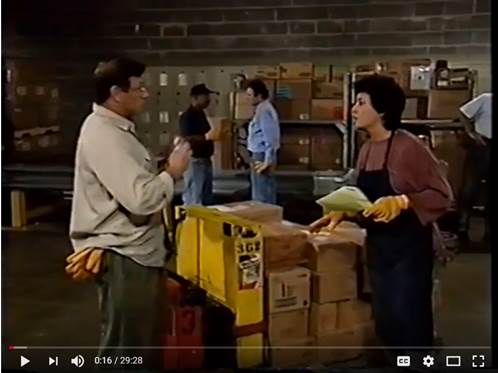Reporting out
Reporting out is a great way to make sure that there is full participation in a classroom, and as facilitators we want to make sure that everybody has a chance to be heard. Our course designs offer clear direction on how to take up reports from small groups, but here are some ideas you could use in meetings that challenge participants to do more and some ideas on how to be more effective:
BackTalk: Reimagining Report-Outs and Group SharesTurn it around
If you have time to fill at the end of a stewards’ class, or a group of participants who are up for a challenge, consider showing the classic training video “Turn It Around” from the Teamsters Union to spark a discussion. Although produced in the 1980s, the situation is still relevant today: how can a local use grievances to mobilize and unify members?

Energy breaks
During every course, there will be times when participants look – and feel – like they need a nap. It’s definitely hard to learn when energy is low! Facilitators can choose to call a break and let everyone walk around, get a coffee, get some air. Facilitators can also use short activities, involving movement and laughter, to energize the group.
Pick an energizer that suits the character of the group. If you think the group won’t be comfortable with anything silly, lead them in some simple stretching exercises. Also, pay attention also to physical limitations. If some participants have physical disabilities or injuries, choose an energizer that can be done while seated.
Here are some simple energizers for union activists:
Games / Energizers / DynamicasSpicing up your classroom
If you have time to fill or need a change of pace in a class, try showing this music video from an Australian band, who dedicate the song to mine workers.
Strange Tenants dedicate the song to mine workers, their families and communities the
world over. The video was shot on location at an old gold mine in Smeaton, Australia.
Follow it up with discussion questions such as:
- What does the line about “who gets the money when it’s all sold” encourage listeners to think about?
- Why is the band contrasting the workers and the owners?
- How does this song make you feel?
How to build community in the union classroom
We want union activists and members to be “ambassadors” for our union, to spread the good word about what we do. It’s important for the survival and growth of the labour movement. Here are some ways that USW facilitators can model good community-building behaviour in the classroom.
Request this file in a different format
Making Q&A sessions better
We all enjoy facilitating and interacting with members during our courses but sometimes we forget what it’s like to be a participant. Here are some things to keep in mind while facilitating:
11 ADULT LEARNER TURNOFFS (AKA – DON’T BE THAT FACILITATOR!)In Steelworker courses, we use good questions to draw on participants’
experience and to deepen their analysis.
We don’t use question-and-answer (Q&A) sessions very often in USW courses,
but you might be asked help organize a conference or run a local union meeting. If these events have key-note speakers, here are some ideas to use good questioning skills to make the Q&A session afterward more productive.
Most conferences leave the audience in “listening mode” most of the time, so it
can make perfect sense to give the participants a voice and allow for some unscripted interaction with the speakers. But the Q&A sessions can end up being the weakest part of the event.
Here are some techniques that bring great results, and that can be used without any kind of preparation:
- Do an inverse Q&A. Pose a question to the audience, asking them to discuss it
with the person sitting next to them. A good question is, “For you, what was a key take-away from this session? What might you do differently going forward?” People love the opportunity to voice their thoughts to someone and unlike the traditional Q&A, this approach allows everybody to have their say. It also helps them network with each other in a natural manner, which is something many conferences don’t really cater to. - Ask for reactions, not just questions. As you open the floor, specifically say
“What are your reactions to all this? Questions are great, but you are also welcome to just share an observation; it doesn’t have to be in the form of a question.” - Have people vet the questions in groups. Simply say, “Please spend a minute or two in small groups, and try to find a good question or a reflection you think is relevant for everybody.” Then invite each group to ask its chosen question.
(From “4 Ways to Fix the Q&A Session” by Thomas Wedell-Wedellsborg, Harvard
Business Review Blog Network, August 19, 2014)
